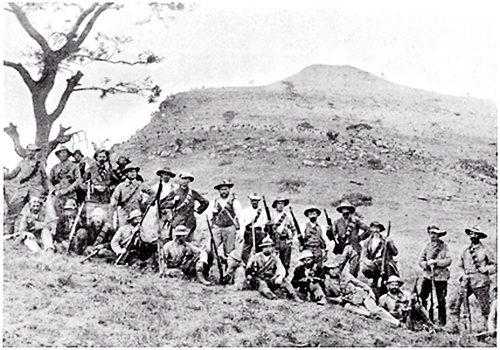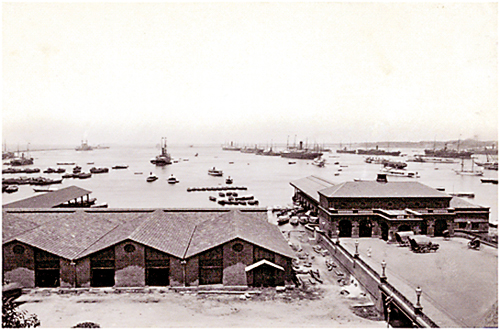Stuff of movies; daring Boer prisoner escapes, cricket match and more

Boer militia at the Battle of Spion Kop in South Africa
One of the first films I watched as an eleven-year-old beginning boarding school in the UK was Young Winston, on the early life of Winston Churchill. Unaware of the Boer conflict on account of a history education more focused on areas like Sri Lanka’s ancient hydraulic civilization, Churchill’s capture by Boers in the movie resembled a well-coordinated attack by bearded cowboys. As such when he escapes captivity and shouts from the roof of a railway carriage: “I am Winston bloody Churchill and I am free,” I appreciated his sentiments but not so much the circumstances.
Forty years on, I did learn about the Boer War and in a twist of destiny its links with my own country. That twist came in 2011 when I was appointed Sri Lanka’s envoy to South Africa. I then became aware of the interest of several South Africans with ancestral links to Boer prisoners of war, in supporting the maintenance of the memorial in Diyatalawa to Boer prisoners who had died in Sri Lanka during imprisonment.
The High Commission in Pretoria has several books with photographs of Boer prisoners in camps in Diyatalawa and Ragama and I recollect Ambassador Moloi, a former South African High Commissioner in India, talking of a shelved plan to produce a documentary on Henri Engelbrecht, a Boer prisoner who had to remain in Sri Lanka as he refused to swear allegiance to the British Crown.
The more I glean on the subject, I have become convinced that the international film industry is overlooking a cinematic opportunity. I should say opportunities. Here’s why.
Young Winston was one of the most successful films at the box office in its year of release. The early life of a notable personality of the 20th Century covering his chequered involvements at Harrow to military escapades as a young army officer aroused fascination. But in my view what brings the film its lustre is its varied international context that includes South Africa, India and Sudan. Charles R. Swindoll’s famous quote is explanatory: ‘a story without context is like a diamond without a mounting. The stone may be beautiful lying loose on a table, but when carefully mounted in the right setting it can dazzle you with its brilliance and sparkling beauty.’ With an international audience in mind, supported also by other countries relevant to parts of the Sri Lanka-Boer prisoner story, I could not think of more appealing settings than South Africa and Sri Lanka.
Diyatalawa where most of the Boers were imprisoned is a picturesque location and the surroundings provide ‘mounting’ to the story. While South Africa has been a location for many international movies, Sri Lanka was the setting for many productions from the wartime classic Bridge on the River Kwai that won seven Academy Awards including Best Picture to Elephant Walk starring Elizabeth Taylor and Indiana Jones and the Temple of Doom.
Setting apart, what’s the plot? The 2016 movie Blood and Glory based on Boer prisoners sent to the island of St. Helena in the Atlantic shows there can be a cinematic story. For a movie relating to Boer prisoners in Sri Lanka, a starting point for the script is a narrative by Dr. R. L. Brohier in the Journal of the Dutch Burgher Union of Ceylon. From such narratives it is evident that the totality of the times of Boer prisoners in Sri Lanka, encompassing a series of stories, provides a movie opportunity. Even certain individual stories do. Here are three with such potential:
The Great Escape
Of 22 escapees from Boer camps in Sri Lanka, 20 were apprehended in the vicinity of the camps and two were recaptured in Rangoon. There was even an unsuccessful tunnelling attempt seen in many World War 2 movies but the escape with the characteristics of an international thriller took place at the Colombo harbour. The story recounted in the book ‘The Great Boer Escape’ by one of the main escapees is summarized below from information in historical journals.
This thrilling escape took place from SS Catalonia which brought a contingent of 300 Boer prisoners to Colombo. 150 were sent by train to Diyatalawa with the train returning the next day to transport the rest. Five of them hatched a daring plan to jump into the water and swim to other ships in the harbour. The five who included William Steyn, an officer in General Jan Smuts’s staff opted for a night-time escape – the challenge lay in regular launch patrols in the harbour – day and night.

Early 20th Century photograph of Colombo Port
Three of the five had decided on swimming to a German ship and two including Steyn to a French vessel. In between these was a three-funnelled Russian ship. Throwing life jackets into the water and lowering themselves down with a rope, the three targeting the German ship went in first. At around 20 minutes to midnight when Steyn lowered himself into the water, cutting himself in the process, he found himself in the direct path of a British patrol boat and escaped by diving underwater.
Struggling in the darkness for about two and a half hours, fearing he may end up swimming to a British ship, Steyn suddenly made out the three funnelled Russian ship and swam towards it. To his surprise he found Russian sailors waiting to assist him and then, to his greater surprise, he found the four other escapees also on board. They had been carried to the Russian ship by the currents and had alerted the Russians that other prisoners may follow.
At 3 a.m. the Russian ship left Colombo. The cinematic potential of the story is enhanced by the global adventure that followed. The ship’s first port of call was Aden where it was boarded by two British officers who provided cables from Colombo giving them reason to believe there were escapees on board. The Captain who had made it a point not to meet the escapees maintained he had not seen them. The ship was thoroughly searched but not the funnel connected to a disused furnace. Hidden, cramped on the furnace ladder were the Boer prisoners.
The next stop was Port Said but they were advised not to disembark. Their daring journey then took them from a Black Sea port to Petersburg, to Berlin, and finally the Netherlands before they returned home.
The indomitable spirit
Boer prisoner Henri Engelbrecht had to remain in Sri Lanka even after the war ended for his courageous refusal to swear an oath to the British crown. As he explained to a friend, he had taken an oath with General De Wit that they would never surrender and therefore, he would only swear the oath if De Wit personally informed him that he had done so.
One can only marvel at the resilience of a man who faced tough financial challenges in Sri Lanka due to his unflinching loyalty. On account of growing public sympathy, he was appointed the first Warden of the Yala National Park. He held this position for 21 years and did much to improve the park. He had a reputation for flamboyance driving a Boer-style tented wagon to collect his monthly allowance, and as a marksman who protected pilgrims visiting the sacred town of Kataragama near the sanctuary. The story is told of the pugmarks of a leopard being discovered by Engelbrecht near a woman pilgrim who had collapsed and died. The wailing of her infant clinging to her breast had kept the animal away but knowing that it would return, Engelbrecht lay in wait and shot it dead preventing a gruesome meal.
A victim of provincial administrative malice, Engelbrecht was accused of communicating with and supporting the German raider warship Emden that had been sinking British ships in the Indian Ocean. He was arrested and spent three months in jail. Released due to lack of evidence, he returned to his Warden’s post at Yala Park. He died in 1922 and was posthumously cleared of charges relating to the Emden.
The cricket match
Last but by no means least, the cricket match between a Boer prisoner team and the Colombo Colts Cricket Club on June 5 and 6, 1901 immediately brings to mind the Indian movie Lagaan – which aroused wider international interest in Bollywood.
But while Lagaan creates an exciting colonial contest by wagering the payment of a tough agricultural tax on the outcome of a cricket match, it is fictional. Conversely given the presence of international level players on the Boer side and Colombo Colts Cricket Club’s status, this game is hailed by cricket historians as the first official match of a South African team in the subcontinent.
Initial opposition to a match with prisoners was overcome. The Boer players P.H. de Villiers and Gerhard Kotze had played international cricket against visiting English teams and they had other notable players including George Sennet and fast bowler Cornelius Otto. Many of the Colombo Colts team were expatriates but they also had excellent local talent like the hardhitting schoolboy C.E. Perera.
Cricket historian Arunabha Sengupta describes the scene and provides a detailed ‘cricinfo’ like match summary. A movie script could build the event as a positive outcome of a challenging period and whilst such a line may be dangerously close to the diplomatic advantage the colonial administration sought to gain, it was likely grounded in reality.
There was a celebratory atmosphere at the match with good crowd participation. De Villiers won the toss and put the Colts into bat. The Boer batting let them down but their bowling was good and at one stage the Colts were 92 for 9. Excellent batting by C.E. Perera adding 54 for the final wicket brought the Colts’ first innings score to 146.
The Boers lost the match but made their mark. So too had sportsmanship. The Boer captive General Olivier and British Governor Ridgeway attended the match. As the Governor departed three cheers were called by the Boer team and the Governor acknowledged by lifting his hat.
Books, journals and newspaper articles of the Boers in Sri Lanka are full of eventful stories, incidents and even humorous anecdotes such a Boer general’s struggles with curry. The big screen awaits a film to project the full flavour of this Sri Lankan engagement or even some of its ingredients. Film scenes of a bustling colonial port, the jungles of Yala, the mystical Kataragama Temple, cricket in Colombo’s tropical heat and train rides through the scenic hill country may entice film directors to revisit this history. One who has already made an adventure film in Sri Lanka might agree:
“History opens up new worlds to film makers all the time” – Stephen Spielberg
(The writer was Sri Lanka’s High Commissioner in South Africa 2011-2014)
Searching for an ideal partner? Find your soul mate on Hitad.lk, Sri Lanka's favourite marriage proposals page. With Hitad.lk matrimonial advertisements you have access to thousands of ads from potential suitors who are looking for someone just like you.


